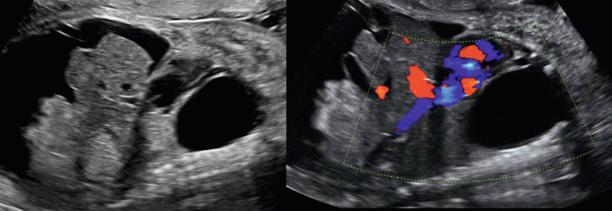Physical Address
304 North Cardinal St.
Dorchester Center, MA 02124
Among rare thoracic tumors not described in previous chapters, two are the most common. Bronchogenic cysts are derived from abnormal budding of the ventricular diverticulum in the mediastinum or the lung. Lymphangiomas arise from the lymphatic system and develop more frequently in the thorax, head, and neck.
A bronchogenic cyst is a cystic duplication of the tracheobronchial tree, derived from an abnormal budding of the ventricular diverticulum of the foregut.
Bronchogenic cysts account for about 20% to 30% of congenital bronchopulmonary foregut cystic malformations. Prevalence is reported as 1 : 42,000, although this could be underestimated because of the high rate of late diagnosis and hidden cases. Half of these cases are diagnosed after 15 years of age. Prenatal diagnosis is only possible in large cysts. A 70% detection rate has been suggested, although the small numbers of cases render any meaningful estimate difficult.
Bronchogenic cysts result from abnormal budding of the ventral diverticulum of the primitive foregut. Most cysts develop between the 26th and 40th days of fetal life. If appearing during early bronchial development, the cyst is located in the mediastinum (30%), normally between the trachea and esophagus, and later it develops in the lung (70%). The cyst wall resembles a bronchus with ciliated respiratory epithelial lining, smooth muscle, cartilaginous structures, and bronchial mucus glands, usually filled with thick mucus.
In children and adults, most cysts are asymptomatic and diagnosed at routine ultrasound or chest radiographs. Prenatally, clinical manifestations will depend on the size, presence of bronchial obstruction or mediastinal shift, and location. Rarely, bronchogenic cysts may obstruct a large bronchus creating a similar effect to bronchial atresia, with impaired fluid drainage distal to the obstruction leading to enlarged hyperechogenic lungs, mediastinal shift, and high risk of lung hypoplasia, polyhydramnios, and hydrops.
A single, well-defined, unilocular, hypoechogenic intrathoracic mass within the lung parenchyma or mediastinum. Mediastinal and large cysts tend to compress the trachea and esophagus, with subsequent polyhydramnios and/or hydrops. ( Fig. 7.1 ). Visualization of small mediastinal cysts can be challenging because of difficult differentiation from other structures, so they should be suspected in the presence of mediastinal enlargement without a clear mass.

Become a Clinical Tree membership for Full access and enjoy Unlimited articles
If you are a member. Log in here